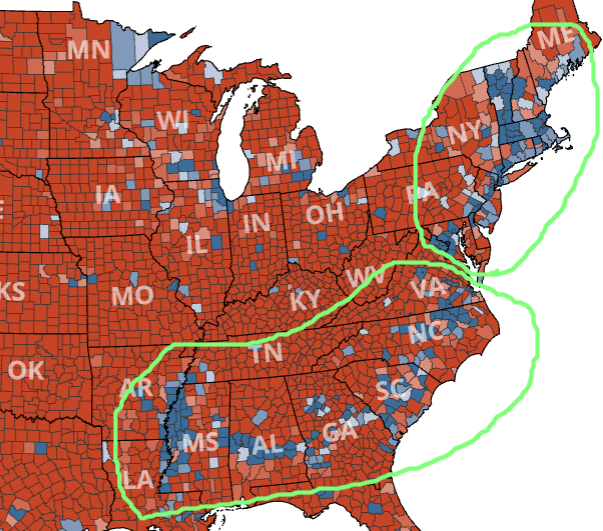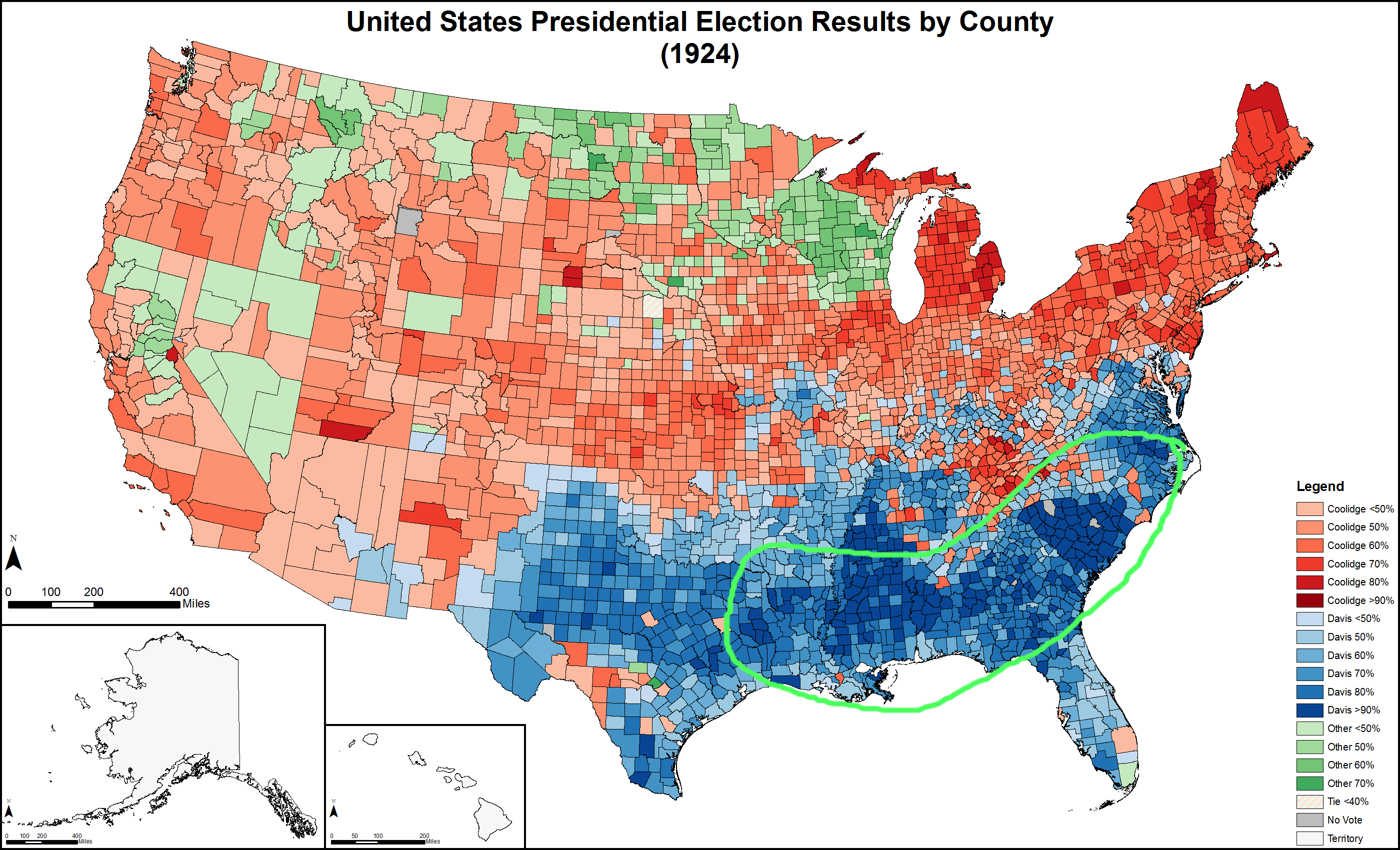A combination of the Black Belt and Northeastern region
What first appeared to be a long unbroken line of counties from north to south actually seems to be made of two major parts.

2016 elections[8]
Northeastern
The blue counties north of Virginia are actually part of a larger area that also skirts the Great Lakes. The reasons why Northeastern United States votes Democrat (or used to) are complex and changing (it was mostly Republican before 1990), but it is unrelated to the rest of the curve.
The emergence of the Northeast as a potential Democratic firewall has been a long time in the making. The steady realignment of the South toward the Republicans, which rendered the party increasingly conservative, called forth a counter-realignment among moderates in the North.[11]
The voting patterns of the Northeastern region would require an answer of its own, but it is related to population density, education, urban centers and social and cultural differences between the North and South. However, this answer mainly focuses on the Black Belt.
Black Belt
The southern part of the "curve" is commonly called the "Black Belt":
There’s an arc of Democratic strength across the interior South. This is the old “Black Belt,” named for the fertile soil that gave rise to cotton plantations. These areas are still populated by a high percentage of African-Americans even 150 years after the end of slavery, and they’re predominantly Democratic today.[1]

Black population by county[3]
Slavery and cotton picking
The soil of the Southeastern regions is fertile and well-drained, making it ideal for cotton. The black population in this region today descends from the slaves that use to work the cotton fields.
Over time this rich soil produced an amazingly productive agricultural region, especially for cotton. In 1859 alone a harvest of over 4,000 cotton bales was not uncommon within the belt. And yet, just tens of miles north or south this harvest was rare. Of course this level of cotton production required extensive labor.
As Washington notes further in his autobiography, "The part of the country possessing this thick, dark, and naturally rich soil was, of course, the part of the South where the slaves were most profitable, and consequently they were taken there in the largest numbers. Later and especially since the war, the term seems to be used wholly in a political sense—that is, to designate the counties where the black people outnumber the white."[2]
The Black Belt on election maps
I went back to previous elections and found that the "blue Black Belt" has been present in many of them.

2000 elections[4]

1984 elections[5]
However, as you go further back, the belt disappears from maps because African-Americans often didn't (or couldn't) vote:
But the Black Belt has not always been visible on maps during elections. The Voting Rights Act, outlawing discriminatory voting practices, was passed in 1965. As result, a year earlier in the 1964 elections larger numbers of African Americans were excluded from the polls in Southern states. And, in turn, the blue band we see today was not visible.[2]
 1924 elections[6], note the uniform blue color across the South (for the red/blue swap, see the Southern Realignment or the Southern strategy)
1924 elections[6], note the uniform blue color across the South (for the red/blue swap, see the Southern Realignment or the Southern strategy)
The black Democrat vote
Before 1948, there was no clear distinction in party identification for African-Americans, although "at no point from 1936 on, according to Joint Center data, has the Republican candidate for president gotten more than 40 percent of the black vote."[7]

Black party identification[7]
There are two major bumps in party identification: 1948 and 1964. In 1948, Democrat Harry Truman talked about civil rights in his state of the union address:
Today, however, some of our citizens are still denied equal opportunity for education, for jobs and economic advancement, and for the expression of their views at the polls. Most serious of all, some are denied equal protection under the laws. Whether discrimination is based on race, or creed, or color, or land of origin, it is utterly contrary to American ideals of democracy.[10]
This was followed by requests to Congress about, among other things, protecting the right to vote.[9]
The second bump in 1964 was the Civil Rights Act by Democrat Lyndon B. Johnson. This Act would outlaw discrimination based on race and color and "ended unequal application of voter registration requirements".
Although these two actions would strengthen the black vote for the Democratic Party, it would also make them mostly unelectable in the Deep South:
When he signed the bill, President Lyndon Johnson reportedly said that Democrats would, as a result, lose the South for a generation. It's been longer than that.[7]
References
[1] What This 2012 Map Tells Us About America, and the Election, Nate Cohn and Toni Monkovic, 18 October 2016, The New York Times
[2] How presidential elections are impacted by a 100 million year old coastline, Dr. M, 27 June 2012, Deep Sea News
[3] Map of contiguous US, showing percentage of population self-reported as "Black," by census tract, 2000., Wikimedia, by user Citynoise
[4] Map showing the results by county of the 2000 United States presidential election specifically identifying the percentage received by the winning candidate in each county, Wikimedia, by user Tilden76
[5] Map showing the results by county of the 1984 United States presidential election specifically identifying the percentage recieved by the winning candidate in each county., Wikimedia, by user Tilden76
[6] Presidential election results by county (1924), Wikimedia, by user Tilden76
[7] When did black Americans start voting so heavily Democratic?, Philip Bump, 7 July 2015, The Washington Post
[8] US elections 2016 live results, The Guardian
[9] Race, Realignment, and the Election of 1948, Jay Cost, 22 April 2009, Clear Politics
[10] Harry S. Truman: Annual Message to the Congress on the State of the Union, The American Presidency Project
[11] Northeast Is the Democrats' Firewall, E.J. Dionne, 27 September 2010, Real Clear Politics









